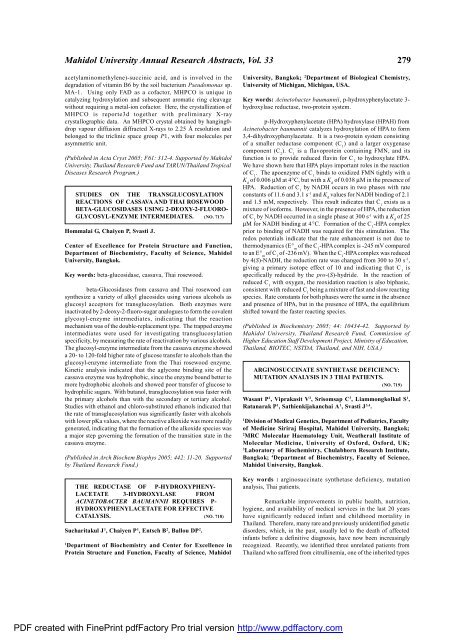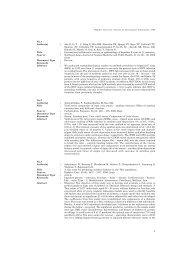Faculty of Science - Mahidol University
Faculty of Science - Mahidol University
Faculty of Science - Mahidol University
Create successful ePaper yourself
Turn your PDF publications into a flip-book with our unique Google optimized e-Paper software.
<strong>Mahidol</strong> <strong>University</strong> Annual Research Abstracts, Vol. 33 279<br />
acetylaminomethylene)-succinic acid, and is involved in the<br />
degradation <strong>of</strong> vitamin B6 by the soil bacterium Pseudomonas sp.<br />
MA-1. Using only FAD as a c<strong>of</strong>actor, MHPCO is unique in<br />
catalyzing hydroxylation and subsequent aromatic ring cleavage<br />
without requiring a metal-ion c<strong>of</strong>actor. Here, the crystallization <strong>of</strong><br />
MHPCO is reporte3d together with preliminary X-ray<br />
crystallographic data. An MHPCO crystal obtained by hanging0drop<br />
vapour diffusion diffracted X-rays to 2.25 Å resolution and<br />
belonged to the triclinic space group P1, with four molecules per<br />
asymmetric unit.<br />
(Published in Acta Cryst 2005; F61: 312-4. Supported by <strong>Mahidol</strong><br />
<strong>University</strong>, Thailand Research Fund and TARUN/Thailand Tropical<br />
Diseases Research Program.)<br />
STUDIES ON THE TRANSGLUCOSYLATION<br />
REACTIONS OF CASSAVA AND THAI ROSEWOOD<br />
BETA-GLUCOSIDASES USING 2-DEOXY-2-FLUORO-<br />
GLYCOSYL-ENZYME INTERMEDIATES. (NO. 717)<br />
Hommalai G, Chaiyen P, Svasti J.<br />
Center <strong>of</strong> Excellence for Protein Structure and Function,<br />
Department <strong>of</strong> Biochemistry, <strong>Faculty</strong> <strong>of</strong> <strong>Science</strong>, <strong>Mahidol</strong><br />
<strong>University</strong>, Bangkok.<br />
Key words: beta-glucosidase, cassava, Thai rosewood.<br />
beta-Glucosidases from cassava and Thai rosewood can<br />
synthesize a variety <strong>of</strong> alkyl glucosides using various alcohols as<br />
glucosyl acceptors for transglucosylation. Both enzymes were<br />
inactivated by 2-deoxy-2-fluoro-sugar analogues to form the covalent<br />
glycosyl-enzyme intermediates, indicating that the reaction<br />
mechanism was <strong>of</strong> the double-replacement type. The trapped enzyme<br />
intermediates were used for investigating transglucosylation<br />
specificity, by measuring the rate <strong>of</strong> reactivation by various alcohols.<br />
The glucosyl-enzyme intermediate from the cassava enzyme showed<br />
a 20- to 120-fold higher rate <strong>of</strong> glucose transfer to alcohols than the<br />
glucosyl-enzyme intermediate from the Thai rosewood enzyme.<br />
Kinetic analysis indicated that the aglycone binding site <strong>of</strong> the<br />
cassava enzyme was hydrophobic, since the enzyme bound better to<br />
more hydrophobic alcohols and showed poor transfer <strong>of</strong> glucose to<br />
hydrophilic sugars. With butanol, transglucosylation was faster with<br />
the primary alcohols than with the secondary or tertiary alcohol.<br />
Studies with ethanol and chloro-substituted ethanols indicated that<br />
the rate <strong>of</strong> transglucosylation was significantly faster with alcohols<br />
with lower pKa values, where the reactive alkoxide was more readily<br />
generated, indicating that the formation <strong>of</strong> the alkoxide species was<br />
a major step governing the formation <strong>of</strong> the transition state in the<br />
cassava enzyme.<br />
(Published in Arch Biochem Biophys 2005; 442: 11-20. Supported<br />
by Thailand Research Fund.)<br />
THE REDUCTASE OF P-HYDROXYPHENY-<br />
LACETATE 3-HYDROXYLASE FROM<br />
ACINETOBACTER BAUMANNII REQUIRES P-<br />
HYDROXYPHENYLACETATE FOR EFFECTIVE<br />
CATALYSIS. (NO. 718)<br />
Sucharitakul J 1 , Chaiyen P 1 , Entsch B 2 , Ballou DP 2 .<br />
1 Department <strong>of</strong> Biochemistry and Center for Excellence in<br />
Protein Structure and Function, <strong>Faculty</strong> <strong>of</strong> <strong>Science</strong>, <strong>Mahidol</strong><br />
<strong>University</strong>, Bangkok; 2 Department <strong>of</strong> Biological Chemistry,<br />
<strong>University</strong> <strong>of</strong> Michigan, Michigan, USA.<br />
Key words: Acinetobacter baumannii, p-hydroxyphenylacetate 3hydroxylase<br />
reductase, two-protein system.<br />
p-Hydroxyphenylacetate (HPA) hydroxylase (HPAH) from<br />
Acinetobacter baumannii catalyzes hydroxylation <strong>of</strong> HPA to form<br />
3,4-dihydroxyphenylacetate. It is a two-protein system consisting<br />
<strong>of</strong> a smaller reductase component (C 1 ) and a larger oxygenase<br />
component (C 2 ). C 1 is a flavoprotein containing FMN, and its<br />
function is to provide reduced flavin for C 2 to hydroxylate HPA.<br />
We have shown here that HPA plays important roles in the reaction<br />
<strong>of</strong> C 1 . The apoenzyme <strong>of</strong> C 1 binds to oxidized FMN tightly with a<br />
K d <strong>of</strong> 0.006 μM at 4°C, but with a K d <strong>of</strong> 0.038 μM in the presence <strong>of</strong><br />
HPA. Reduction <strong>of</strong> C 1 by NADH occurs in two phases with rate<br />
constants <strong>of</strong> 11.6 and 3.1 s -1 and K d values for NADH binding <strong>of</strong> 2.1<br />
and 1.5 mM, respectively. This result indicates that C 1 exists as a<br />
mixture <strong>of</strong> is<strong>of</strong>orms. However, in the presence <strong>of</strong> HPA, the reduction<br />
<strong>of</strong> C 1 by NADH occurred in a single phase at 300 s -1 with a K d <strong>of</strong> 25<br />
μM for NADH binding at 4°C. Formation <strong>of</strong> the C 1 -HPA complex<br />
prior to binding <strong>of</strong> NADH was required for this stimulation. The<br />
redox potentials indicate that the rate enhancement is not due to<br />
thermodynamics (E° m <strong>of</strong> the C 1 -HPA complex is -245 mV compared<br />
to an E° m <strong>of</strong> C 1 <strong>of</strong> -236 mV). When the C 1 -HPA complex was reduced<br />
by 4(S)-NADH, the reduction rate was changed from 300 to 30 s -1 ,<br />
giving a primary isotope effect <strong>of</strong> 10 and indicating that C 1 is<br />
specifically reduced by the pro-(S)-hydride. In the reaction <strong>of</strong><br />
reduced C 1 with oxygen, the reoxidation reaction is also biphasic,<br />
consistent with reduced C 1 being a mixture <strong>of</strong> fast and slow reacting<br />
species. Rate constants for both phases were the same in the absence<br />
and presence <strong>of</strong> HPA, but in the presence <strong>of</strong> HPA, the equilibrium<br />
shifted toward the faster reacting species.<br />
(Published in Biochemistry 2005; 44: 10434-42. Supported by<br />
<strong>Mahidol</strong> <strong>University</strong>, Thailand Research Fund, Commission <strong>of</strong><br />
Higher Education Staff Development Project, Ministry <strong>of</strong> Education,<br />
Thailand, BIOTEC, NSTDA, Thailand, and NIH, USA.)<br />
ARGINOSUCCINATE SYNTHETASE DEFICIENCY:<br />
MUTATION ANALYSIS IN 3 THAI PATIENTS.<br />
(NO. 719)<br />
Wasant P 1 , Viprakasit V 2 , Srisomsap C 3 , Liammongkolkul S 1 ,<br />
Ratanarak P 1 , Sathienkijakanchai A 1 , Svasti J 3,4 .<br />
1 Division <strong>of</strong> Medical Genetics, Department <strong>of</strong> Pediatrics, <strong>Faculty</strong><br />
<strong>of</strong> Medicine Siriraj Hospital, <strong>Mahidol</strong> <strong>University</strong>, Bangkok;<br />
2 MRC Molecular Haematology Unit, Weatherall Institute <strong>of</strong><br />
Molecular Medicine, <strong>University</strong> <strong>of</strong> Oxford, Oxford, UK;<br />
3 Laboratory <strong>of</strong> Biochemistry, Chulabhorn Research Institute,<br />
Bangkok; 4 Department <strong>of</strong> Biochemistry, <strong>Faculty</strong> <strong>of</strong> <strong>Science</strong>,<br />
<strong>Mahidol</strong> <strong>University</strong>, Bangkok.<br />
Key words : arginosuccinate synthetase deficiency, mutation<br />
analysis, Thai patients.<br />
Remarkable improvements in public health, nutrition,<br />
hygiene, and availability <strong>of</strong> medical services in the last 20 years<br />
have significantly reduced infant and childhood mortality in<br />
Thailand. Therefore, many rare and previously unidentified genetic<br />
disorders, which, in the past, usually led to the death <strong>of</strong> affected<br />
infants before a definitive diagnosis, have now been increasingly<br />
recognized. Recently, we identified three unrelated patients from<br />
Thailand who suffered from citrullinemia, one <strong>of</strong> the inherited types<br />
PDF created with FinePrint pdfFactory Pro trial version http://www.pdffactory.com
















